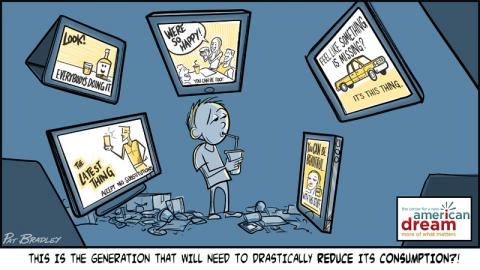
6 Ways to Resist Kid-Targeted Advertising (and Save the Planet!)
Research shows that the more people care about money, wealth, and possessions, the less they value protecting the environment. Materialistic values correlate negatively with how often adults and children engage in pro-environmental behaviors such as commuting by bike, reusing paper, buying secondhand, and recycling.
One study found that among 20 of the wealthiest nations in the world, those whose citizens are most focused on money and achievement have higher levels of carbon dioxide emissions, even after controlling for gross domestic product (GDP).
In a 2010 article in Solutions Journal, Tim Kasser, Tom Crompton, and Susan Linn argue that limiting marketing to children should be seen as part of the solution to our current environmental problems. They note that “the same generation of children that is being encouraged to prioritize wealth, consumption, and possessions is the same generation that, if current trends continue, will need to drastically reduce its consumption patterns so as to prevent further global climate disruption, habitat loss, and species extinction.”
Because children have less-developed cognitive capacities than adults, they are particularly susceptible to the onslaught of advertisements that encourage them to value materialistic claims. Rather than preparing kids to adopt more sustainable lifestyles in the coming decades, today’s culture “encourages their adoption of materialistic messages through the television, through targeted messages on their cell phones and Facebook pages, and through viral marketing on the Internet.”
By reducing our children’s exposure to marketing now, we will be helping them prepare for the changes ahead. Here are six ways to push back against advertising:
1) Limit screen time
Today’s 8- to 18-year-olds consume an average of 7 hours and 38 minutes of screen media per day. And, given that kids often interact with more than one medium at a time, today’s youth pack a staggering 10 hours and 45 worth of media content into those 7.5 hours.
If you find limiting screen time difficult, start by establishing “screen-free” zones in your home, restricting screen time during homework and meals, and/or limiting viewing to ad-free programs or games. A 2014 study found that children whose parents set more limits on the amount and content of media viewed got more sleep, gained less weight, got better grades, exhibited more cooperative social behaviors, and were less aggressive with their peers.
2) Say yes to quality time
When you say no to a screen or gadget, say yes to something your child really wants: time with you. Encourage fun family activities like bike rides, board games, and walks around the neighborhood. Studies have found that exposure to natural settings may be effective in reducing symptoms of ADHD and that children’s stress levels fall within minutes of seeing green spaces. Try limiting your own screen time as well: research shows that parent TV time has a stronger relationship to child TV time than access to TV in the home of the child’s bedroom, or even parental rules about TV viewing.
3) Encourage exposure to ads while in your presence
No matter how much you try to reduce their exposure to advertising, your kids will still see ads, whether on buses, on buildings, or in the classroom. In fact, you may want to encourage a reasonable amount of exposure while in your presence. Dutch researchers found that “active mediation”—making deliberate comments and judgments about commercials and actively explaining their selling intent—was more effective than sheltering children from ads. Look for opportunities to help your kids understand what ads are and how to decode them; teach them the difference between a TV program and a commercial, showing them when a commercial begins and ends. Teach them to ask critical questions like: Who is responsible for the ad? What is it actually saying? Does it leave out any critical information? What does the ad want me to do?
4) Talk to your kids about protecting their online privacy
Explain that they may unknowingly give advertisers a lot of information just by downloading an app or clicking on a sweepstakes. Teach them to ask your permission before clicking on an ad, participating in an online quiz, or filling out a form. Get to know which games and apps your child is using, and have them show you how they are used, what kind of information they ask for, and what sorts of awards they provide. Invest the time to really understand this content, and if you don’t approve of the marketing tactics, steer your kids toward games or apps that you find acceptable.
5) Stock up on great reads
Stock your home with high-quality books, magazines, and articles for your kids to read. As Joe Kelly, a.k.a. The Dad Man, has noted, provide these materials even if your child hasn’t asked for them: “It’s like stocking the kitchen with healthy snacks, even if she begs only for chips and soda.”
6) Conduct a school walk-through
Gather other concerned parents or community members to do a walk-through of your school. Look for examples of sponsored materials such as textbooks, computer banner ads, vending machines, and cafeteria banners. Record the information and report it to the local school board with your concerns. For more information on how to conduct a walkthrough, check out the Center for a New American Dream’s Schools Unbranded Action Kit.
For more information, tips, and inspiration, download your free copy of Kids Unbranded: Tips for Parenting in a Commercial Culture.



The views and opinions expressed in this post are those of the author(s) and do not necessarily reflect those of MomsRising.org.
MomsRising.org strongly encourages our readers to post comments in response to blog posts. We value diversity of opinions and perspectives. Our goals for this space are to be educational, thought-provoking, and respectful. So we actively moderate comments and we reserve the right to edit or remove comments that undermine these goals. Thanks!